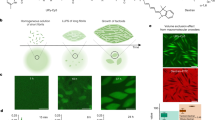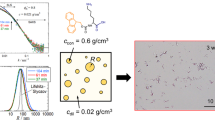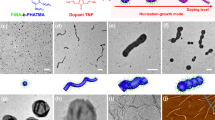Abstract
The self-assembly of amphiphilic molecules in solution is a ubiquitous process in both natural and synthetic systems. The ability to effectively control the structure and properties of these systems is essential for tuning the quality of their functionality, yet the underlying mechanisms governing the transition from molecules to assemblies have not been fully resolved. Here we describe how amphiphilic self-assembly can be preceded by liquid–liquid phase separation. The assembly of a model block co-polymer system into vesicular structures was probed through a combination of liquid-phase electron microscopy, self-consistent field computations and Gibbs free energy calculations. This analysis shows the formation of polymer-rich liquid droplets that act as a precursor in the bottom-up formation of spherical micelles, which then evolve into vesicles. The liquid–liquid phase separation plays a role in determining the resulting vesicles’ structural properties, such as their size and membrane thickness, and the onset of kinetic traps during self-assembly.
This is a preview of subscription content, access via your institution
Access options
Access Nature and 54 other Nature Portfolio journals
Get Nature+, our best-value online-access subscription
$29.99 / 30 days
cancel any time
Subscribe to this journal
Receive 12 print issues and online access
$259.00 per year
only $21.58 per issue
Buy this article
- Purchase on Springer Link
- Instant access to full article PDF
Prices may be subject to local taxes which are calculated during checkout





Similar content being viewed by others
Code availability
The matlab script used for image analysis is available from the corresponding author upon reasonable request. The SCF code was provided by F. Leermakers of Wageningen University.
Data availability
All data supporting the findings of this study, including the SCF input files, the data generated by the SCF computations, and the source data for the figures, are available within the Article and its Supplementary Information and/or from the corresponding authors upon reasonable request
References
Zhang, L. & Eisenberg, A. Multiple morphologies of ‘crew-cut’ aggregates of polystyrene-b-poly(acrylic acid) block copolymers. Science 268, 1728–1731 (1995).
Discher, B. M. et al. Polymersomes: tough vesicles made from diblock copolymers. Science 284, 1143–1146 (1999).
Holder, S. J. & Sommerdijk, N. A. J. M. New micellar morphologies from amphiphilic block copolymers: disks, toroids and bicontinuous micelles. Polym. Chem. 2, 1018–1028 (2011).
Whitesides, G. M. & Grzybowski, B. Self-assembly at all scales. Science 295, 2418–2421 (2002).
Israelachvili, J. N., Mitchell, D. J. & Ninham, B. W. Theory of self-assembly of lipid bilayers and vesciles. Biochim. Biophys. Acta 470, 185–201 (1977).
Antonietti, M. & Forster, S. Vesicles and liposomes: a self-assembly principle beyond lipids. Adv. Mater. 15, 1323–1333 (2003).
Discher, D. E. & Eisenberg, A. Polymer vesicles. Science 297, 967–973 (2002).
Patterson, J. P., Xu, Y., Moradi, M. A., Sommerdijk, N. A. J. M. & Friedrich, H. CryoTEM as an advanced analytical tool for materials chemists. Acc. Chem. Res. 50, 1495–1501 (2017).
Patterson, J. P., Robin, M. P., Chassenieux, C., Colombani, O. & O’Reilly, R. K. The analysis of solution self-assembled polymeric nanomaterials. Chem. Soc. Rev. 43, 2412–2425 (2014).
Zhang, Q., Lin, J., Wang, L. & Xu, Z. Theoretical modeling and simulations of self-assembly of copolymers in solution. Prog. Polym. Sci. 75, 1–30 (2017).
Whitelam, S. & Jack, R. L. The statistical mechanics of dynamic pathways to self-assembly. Annu. Rev. Phys. Chem. 66, 143–163 (2015).
Wright, D. B. et al. Blending block copolymer micelles in solution: obstacles of blending. Polym. Chem. 7, 1577–1583 (2016).
Batzri, S. & Korn, E. D. Single bilayer liposomes prepared without sonication. Biochim. Biophys. Acta Biomembranes 298, 1015–1019 (1973).
Yu, Y. S., Zhang, L. F. & Eisenberg, A. Morphogenic effect of solvent on crew-cut aggregates of apmphiphilic diblock copolymers. Macromolecules 31, 1144–1154 (1998).
Zhuang, J., Gordon, M. R., Ventura, J., Li, L. & Thayumanavan, S. Multi-stimuli responsive macromolecules and their assemblies. Chem. Soc. Rev. 42, 7421–7435 (2013).
Du, J., Tang, Y., Lewis, A. L. & Armes, S. P. pH-sensitive vesicles based on a biocompatible zwitterionic diblock copolymer. J. Am. Chem. Soc. 127, 17982–17983 (2005).
Mai, Y. & Eisenberg, A. Self-assembly of block copolymers. Chem. Soc. Rev. 41, 5969–5985 (2012).
Warren, N. J. & Armes, S. P. Polymerization-induced self-assembly of block copolymer nano-objects via RAFT aqueous dispersion polymerization. J. Am. Chem. Soc. 136, 10174–10185 (2014).
Charleux, B., Delaittre, G., Rieger, J. & D’Agosto, F. Polymerization-induced self-assembly: from soluble macromolecules to block copolymer nano-objects in one step. Macromolecules 45, 6753–6765 (2012).
Flory, P. J. in Principles of Polymer Chemistry 106–110 (Cornell Univ. Press, Ithaca, 1953).
Van de Witte, P., Dijkstra, P. J., Van den Berg, J. & Feijen, J. Phase separation processes in polymer solutions in relation to membrane formation. J. Membr. Sci. 117, 1–31 (1996).
Sato, T. & Takahashi, R. Competition between the micellization and the liquid–liquid phase separation in amphiphilic block copolymer solutions. Polym. J. 49, 273–277 (2017).
Denkova, A. G., Bomans, P. H. H., Coppens, M. O., Sommerdijk, N. A. J. M. & Mendes, E. Complex morphologies of self-assembled block copolymer micelles in binary solvent mixtures: the role of solvent–solvent correlations. Soft Matter 7, 6622–6628 (2011).
Zhu, Y. Q., Yang, B., Chen, S. & Du, J. Z. Polymer vesicles: mechanism, preparation, application, and responsive behavior. Prog. Polym. Sci. 64, 1–22 (2017).
Poschenrieder, S. T., Schiebel, S. K. & Castiglione, K. Polymersomes for biotechnological applications: large-scale production of nano-scale vesicles. Eng. Life Sci. 17, 58–70 (2017).
Du, J. Z. & O’Reilly, R. K. Advances and challenges in smart and functional polymer vesicles. Soft Matter 5, 3544–3561 (2009).
Adams, D. J. et al. On the mechanism of formation of vesicles from poly(ethylene oxide)-block-poly(caprolactone) copolymers. Soft Matter 5, 3086–3096 (2009).
Ghoroghchian, P. P. et al. Bioresorbable vesicles formed through spontaneous self-assembly of amphiphilic poly(ethylene oxide)-block-polycaprolactone. Macromolecules 39, 1673–1675 (2006).
Ross, F. M. Liquid Cell Electron Microscopy (Cambridge Univ. Press, Cambridge, 2016).
Ross, F. M. Opportunities and challenges in liquid cell electron microscopy. Science 350, 9886 (2015).
De Yoreo, J. J. & Sommerdijk, N. A. J. M. Investigating materials formation with liquid-phase and cryogenic TEM. Nat. Rev. Mater. 1, 16035 (2016).
Fleer, G. L., Cohen Stuart, M. A., Scheutjens, J. M. H. M., Cosgrove, T. & Vincent, B. Polymers at Interfaces (Springer Science & Business Media, Berlin, 1993).
Grulke, E. A., Immergut, E. & Brandrup, J. Polymer Handbook (Wiley, New York, 1999).
ten Wolde, P. R. & Frenkel, D. Enhancement of protein crystal nucleation by critical density fluctuations. Science 277, 1975–1978 (1997).
Yamazaki, T. et al. Two types of amorphous protein particles facilitate crystal nucleation. Proc. Natl Acad. Sci. USA 114, 2154–2159 (2017).
Wallace, A. F. et al. Microscopic evidence for liquid–liquid separation in supersaturated CaCO3 solutions. Science 341, 885–889 (2013).
Loh, N. D. et al. Multistep nucleation of nanocrystals in aqueous solution. Nat. Chem. 9, 77–82 (2017).
De Yoreo, J. J. et al. Crystallization by particle attachment in synthetic, biogenic, and geologic environments. Science 349, 6760 (2015).
Smeets, P. J. et al. A classical view on nonclassical nucleation. Proc. Natl Acad. Sci. USA 114, E7882–E7890 (2017).
Ianiro, A., Jiménez-Pardo, I., Esteves, A. C. C. & Tuinier, R. One-pot, solvent-free, metal-free synthesis and UCST-based purification of poly(ethylene oxide)/poly-ε-caprolactone block copolymers. J. Polym. Sci. A 54, 2992–2999 (2016).
Ianiro, A. et al. A roadmap for poly(ethylene oxide)-block-poly-ε-caprolactone self-assembly in water: prediction, synthesis, and characterization. J. Polym. Sci. B 56, 330–339 (2018).
Elsabahy, M. & Wooley, K. L. Design of polymeric nanoparticles for biomedical delivery applications. Chem. Soc. Rev. 41, 2545–2561 (2012).
de Jonge, N. & Ross, F. M. Electron microscopy of specimens in liquid. Nat. Nanotechnol. 6, 695–704 (2011).
Proetto, M. T. et al. Dynamics of soft nanomaterials captured by transmission electron microscopy in liquid water. J. Am. Chem. Soc. 136, 1162–1165 (2014).
Smeets, P. J., Cho, K. R., Kempen, R. G., Sommerdijk, N. A. & De Yoreo, J. J. Calcium carbonate nucleation driven by ion binding in a biomimetic matrix revealed by in situ electron microscopy. Nat. Mater. 14, 394–399 (2015).
Patterson, J. P. et al. Observing the growth of metal–organic frameworks by in situ liquid cell transmission electron microscopy. J. Am. Chem. Soc. 137, 7322–7328 (2015).
Barnhill, S. A., Bell, N. C., Patterson, J. P., Olds, D. P. & Gianneschi, N. C. Phase diagrams of polynorbornene amphiphilic block copolymers in solution. Macromolecules 48, 1152–1161 (2015).
Keßler, S., Drese, K. & Schmid, F. Simulating copolymeric nanoparticle assembly in the co-solvent method: how mixing rates control final particle sizes and morphologies. Polymer 126, 9–18 (2017).
Parent, L. R. et al. Directly observing micelle fusion and growth in solution by liquid-cell transmission electron microscopy. J. Am. Chem. Soc. 139, 17140–17151 (2017).
Schneider, N. M. et al. Electron–water interactions and implications for liquid cell electron microscopy. J. Phys. Chem. C 118, 22373–22382 (2014).
Woehl, T. J. & Abellan, P. Defining the radiation chemistry during liquid cell electron microscopy to enable visualization of nanomaterial growth and degradation dynamics. J. Microsc. 265, 135–147 (2017).
Parent, L. R. et al. Tackling the challenges of dynamic experiments using liquid-cell transmission electron microscopy. Acc. Chem. Res. 51, 3–11 (2018).
Hill, T. L. Thermodynamics of Small Systems (Courier Corporation, Chelmsford, 1963).
Lebouille, J. G. J. L. et al. Controlled block copolymer micelle formation for encapsulation of hydrophobic ingredients. Eur. Phys. J. E 36, 107 (2013).
Kita-Tokarczyk, K., Grumelard, J., Haefele, T. & Meier, W. Block copolymer vesicles—using concepts from polymer chemistry to mimic biomembranes. Polymer 46, 3540–3563 (2005).
Adams, D. J., Adams, S., Atkins, D., Butler, M. F. & Furzeland, S. Impact of mechanism of formation on encapsulation in block copolymer vesicles. J. Control Rel. 128, 165–170 (2008).
He, X. & Schmid, F. Dynamics of spontaneous vesicle formation in dilute solutions of amphiphilic diblock copolymers. Macromolecules 39, 2654–2662 (2006).
Acknowledgements
J.P.P. was supported by the 4TU High-Tech Materials research program ‘New Horizons in Designer Materials’ and the Marie Sklodowska-Curie Action project ‘LPEMM’. H.W. and M.P.V. are supported by the EU H2020 Marie Sklodowska-Curie Action project ‘MULTIMAT’. The authors thank M. Goudzwaard (Eindhoven University of Technology, the Netherlands) for help with making angular maps and radial-averaged intensity maps.
Author information
Authors and Affiliations
Contributions
J.P.P. and N.A.J.M.S. supervised the study. J.P.P., N.A.J.M.S. and A.I conceived the experiments. H.W., J.P.P. and M.P.V. performed the LPEM experiments. A.C.C.E. and A.I. were responsible for the polymer synthesis and characterization. R.T. and A.I. developed the SCF computations. A.I. developed the theoretical framework. H.F. supervised the movie analysis. A.D.A.K. removed the duplicate frames and stabilized the movies. H.W. developed and conducted the sub-alignments and quantitative analysis. M.M.J.v.R. performed the cryo-TEM experiments. J.P.P. wrote the paper with contributions from all authors. All authors discussed the results and commented on the manuscript.
Corresponding authors
Ethics declarations
Competing interests
The authors declare no competing interests
Additional information
Publisher’s note: Springer Nature remains neutral with regard to jurisdictional claims in published maps and institutional affiliations.
Supplementary information
Supplementary Information
Description of the methodologies used, and supplementary in-depth discussions and supplementary data.
Supplementary Movie 1
LPEM Movie of the in-situ self-assembly experiment. Unprocessed movie.
Supplementary Movie 2
LPEM movie of the in-situ self-assembly experiment. Stabilized and cropped movie. Acquisition frame rate: 30 fps; Electron dose rate: 30 electrons.nm-2.s-1; Playback frame rate: 50 fps.
Supplementary Movie 3
LPEM movie of the membrane formation process of vesicle 1. Electron dose rate: 30 electrons.nm−2.s−1; Playback frame rate: 100 fps.
Supplementary Movie 4
Control Experiment 1. LPEM movie of pure acetone. Electron dose rate: 30 electrons.nm−2.s−1; Playback frame rate: 80 fps.
Supplementary Movie 5
Control Experiment 2. LPEM movie of polymer in acetone. Electron dose rate: 30 electrons.nm−2.s−1; Playback frame rate: 80 fps.
Supplementary Movie 6
Control Experiment 3. Self-assembly of the vesicles in the liquid cell without imaging.
Supplementary Movie 7
Control Experiment 4. LPEM movie of preformed vesicle.
Supplementary Movie 8
Control Experiment 6. LPEM movie showing a second example of the in-situ self-assembly experiment.
Supplementary Movie 9
Control Experiment 6. LPEM movie showing a cropped single particle from Supplementary Movie 8.
Supplementary Movie 10
Control Experiment 6. LPEM movie shows a third example of the in-situ self-assembly experiment.
Rights and permissions
About this article
Cite this article
Ianiro, A., Wu, H., van Rijt, M.M.J. et al. Liquid–liquid phase separation during amphiphilic self-assembly. Nat. Chem. 11, 320–328 (2019). https://doi.org/10.1038/s41557-019-0210-4
Received:
Accepted:
Published:
Issue Date:
DOI: https://doi.org/10.1038/s41557-019-0210-4
This article is cited by
-
Controlling liquid–liquid phase behaviour with an active fluid
Nature Materials (2023)
-
Asymmetric block copolymer membrane fabrication mechanism through self-assembly and non-solvent induced phase separation (SNIPS) process
Scientific Reports (2022)
-
Self-assembly of Amphiphilic Diblock Copolymers Induced by Liquid-Liquid Phase Separation
Chinese Journal of Polymer Science (2021)
-
Biomolecular condensates undergo a generic shear-mediated liquid-to-solid transition
Nature Nanotechnology (2020)
-
Ring-opening polymerization-induced crystallization-driven self-assembly of poly-L-lactide-block-polyethylene glycol block copolymers (ROPI-CDSA)
Nature Communications (2020)



